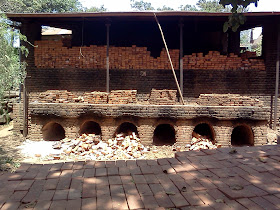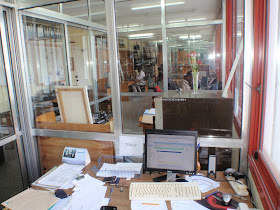(It will take some months to finish this post, I dont have pics of all the process.)
This is how we are currently making clay bricks. We use clay from our site , add 40% volcanic sand, mix, mould, dry, stack kiln, burn with waste charcoal dust, cool, stack outside for sale.
Getting the clay.Volcanic Sand.Mixing the clay and sand.These guys are strong and fit. In square pits the mix clay and sand 60/40%. They add water and mix with their feet like grape wine making. We let it sit a day, then mix again.

The brick mould is metal with 4 partitions. It is cleaned in the sink to the left. There is a board underneath.

they know pretty exactly how much to put in the moulds with shovels.


He presses the mixture into the moulds

thens smoothens it out and removes excess or adds it not enough.

Erasto carries the mould onto the cement floor and flipped over nesxt to the last one.

the plate is slid off the top and the either smoothed with a board or their hands.

then the mould is lifted straight up. We get a slight variation on brick thickness, 1-3 mm difference. When building the bricks should be laid upside down to how they were stamped out.
 DRYING
DRYINGThe bricks are let to dry for 1-2 days. A good moulder can do 400-600 bricks a day. It is piece work .

Once they are stiff they scrap off any lip on the brick cornors on the bottom and stand the brick up for 2-3 days to dry faster.

then the bricks are stacked up to the ceiling for 3-5 weeks of drying.

STACKING KILN
As they become dry we stack the kiln. The kiln has 6 tunnels. Some years ago they were left open and logs were pushed in for 3-4 days to burn the bricks. Firewood is expensive, scarce, and unethical. So we learned to burn using waste charcoal dust. Most of the tunnels are filled with charcoal bricks we make. they are stacked loose. In the first few courses we put these same charcoal bricks about 1/6. after course 10 we sprinkle the dust on top of each course.. Bricks are stacked loosely. We put in 24 courses, about 3.5 meters high.
a later of old reject bricks is packed tightly over the whole kiln as insullation.
burning.We start the kiln with firewood in the morning. we brick up the openings by noon.
second day we add some more wood. then the charcoal burns it way slowly in the next 3-4 days.

after burning and cooling we have to remove the bricks and stack outside. Dust work. They have masks but mostly choose not to wear.

this particular burning something happened and 1/3 of the bricks are under burnt. useable but not top quality.


Hussein is carrying 18 bricks. 54kgs or 120lbs. Each person removes and stacks 1000 bricks per day.

Broken bricks . Some are useable some are now rubble.

The kiln is x . Rainwater is caught off the roof. The bricks on top of the wall are used later to cover the kiln as insulation.



















































